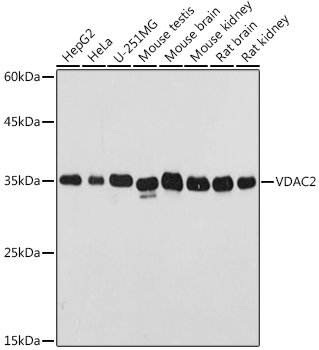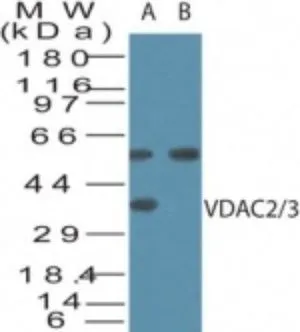VDAC2 antibody [N1C2]
GTX114876
ApplicationsWestern Blot, ImmunoHistoChemistry, ImmunoHistoChemistry Paraffin
Product group Antibodies
ReactivityHuman, Mouse, Rat
TargetVDAC2
Overview
- SupplierGeneTex
- Product NameVDAC2 antibody [N1C2]
- Delivery Days Customer9
- Application Supplier NoteWB: 1:500-1:3000. IHC-P: 1:100-1:1000. *Optimal dilutions/concentrations should be determined by the researcher.Not tested in other applications.
- ApplicationsWestern Blot, ImmunoHistoChemistry, ImmunoHistoChemistry Paraffin
- CertificationResearch Use Only
- ClonalityPolyclonal
- Concentration1 mg/ml
- ConjugateUnconjugated
- Gene ID7417
- Target nameVDAC2
- Target descriptionvoltage dependent anion channel 2
- Target synonymsPOR, non-selective voltage-gated ion channel VDAC2, epididymis secretory sperm binding protein, outer mitochondrial membrane protein porin 2
- HostRabbit
- IsotypeIgG
- Protein IDP45880
- Protein NameNon-selective voltage-gated ion channel VDAC2
- Scientific DescriptionThis gene encodes a member of the voltage-dependent anion channel pore-forming family of proteins that are considered the main pathway for metabolite diffusion across the mitochondrial outer membrane. The encoded protein is also thought to be involved in the mitochondrial apoptotic pathway via regulation of BCL2-antagonist/killer 1 protein activity. Pseudogenes have been identified on chromosomes 1, 2, 12 and 21, and alternative splicing results in multiple transcript variants. [provided by RefSeq]
- ReactivityHuman, Mouse, Rat
- Storage Instruction-20°C or -80°C,2°C to 8°C
- UNSPSC12352203
References
- Chen WM, Chiang JC, Shang Z, et al. DNA-PKcs and ATM modulate mitochondrial ADP-ATP exchange as an oxidative stress checkpoint mechanism. EMBO J. 2023,42(6):e112094. doi: 10.15252/embj.2022112094Read this paper
- Chai P, Cheng Y, Hou C, et al. USP19 promotes hypoxia-induced mitochondrial division via FUNDC1 at ER-mitochondria contact sites. J Cell Biol. 2021,220(7). doi: 10.1083/jcb.202010006Read this paper
- Zheng P, Chen Q, Tian X, et al. DNA damage triggers tubular endoplasmic reticulum extension to promote apoptosis by facilitating ER-mitochondria signaling. Cell Res. 2018,28(8):833-854. doi: 10.1038/s41422-018-0065-zRead this paper







